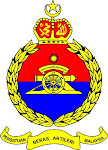The GPO shouted his fire orders from the command post:
“HE M51 CHAAAAAARGE Seven”
“Bearing 4500 mils”
“Angle of sight 4 mils”
“10,000!!!!”
I presume there would be very few GPOs who had ordered Charge Seven. Not then not now.
Charge Seven had been a restricted charge since the 1960s; to be fired in operational areas only. It is also the only charge to be used in anti-tank fire. The downside to using Charge Seven was of course wear and tear of the gun barrel. Charge Seven is equivalent to one EFC or Equivalent Full A battery of six guns should have approximately the same EFC values in all the six guns. This was to ensure consistency in the spread of the fall of shots. All guns were to be inspected and measured for EFC values (life of the barrel) and caliberated before fire. Guns within the battery should not have a mixed of old and new barrels. Half worn barrels were restricted from firing danger close missions.
I find Charge Seven was more consistent and had a shorter time of flight at similiar ranges using lower charges. It was also used for high angle targets.
We often fired targets at our maximum ranges during Confrontation and in the border ops. I loved Charge Seven. It gives me the most satisfaction in gun fire. The bangs were extra loud and the cordite smell was almost nauseating during Fire for Effect in battery missions. The gun barrel goes back to full recoil when firing Charge Seven. The breech block would almost kiss the ground when firing high angle. We would have to dig a sink hole to cater for high angle fire.
Charge Seven is the last charge bag linked-tied together with six other charge bags in the cartridge shell. The charge bags were of different sizes and were made of silk cloth for easy combustion. From the picture above we note the Charge Seven bag is the bigest bag of the six. Charge One is somewhat flat so that the bag could wrap rounf the long primer in the cartridge shell. If we were firing Charge Five, we would have to remove the Charge Six and Charge Seven bags. And it was always a great shame to burn all the excess charge bags at the end of the live firing exercises in Asahan. The black charge propellents were very combustible and would have made very good fireworks. The cartridge shells were made of solid brass making excellent ash trays. Oh those were the days.
Allen Lai


No comments:
Post a Comment